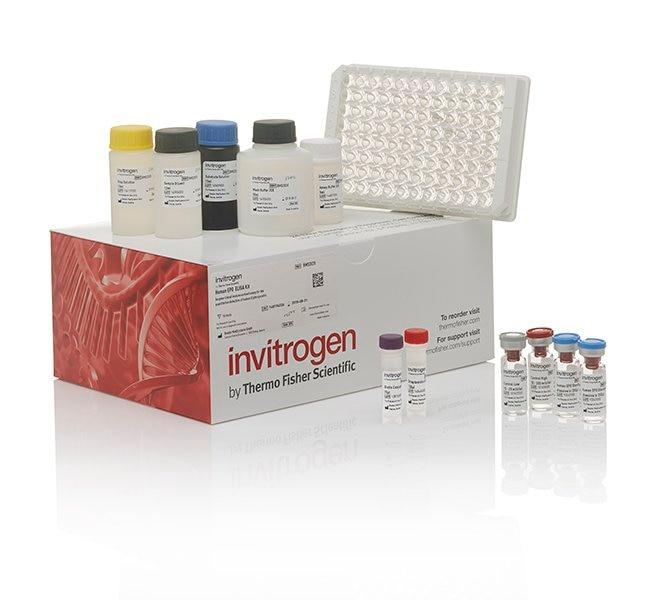Search Thermo Fisher Scientific
Product Specifications
Analytical sensitivity
Assay range
Sample type/volume
Hands-on time
Time-to-result
Homogenous (no wash)
Interassay CV
Intraassay CV
Instrument
Product size
Contents
Standard
Assay Diluent concentrate
Biotinylated Detection Antibody
SAV-HRP
Wash Buffer
Chromogen
Stop Solution
Adhesive Plate Covers
Shipping conditions
Storage
Protein name
Protein family
Species (tested)
Assay kit format
Detector antibody conjugate
Label or dye
About This Kit
The Human Endostatin ELISA quantitates Hu Endostatin in human serum, plasma, or cell culture medium. The assay will exclusively recognize both natural and recombinant Hu Endostatin.
Principle of the method
The Human Endostatin solid-phase sandwich ELISA (enzyme-linked immunosorbent assay) is designed to measure the amount of the target bound between a matched antibody pair. A target-specific antibody has been pre-coated in the wells of the supplied microplate. Samples, standards, or controls are then added into these wells and bind to the immobilized (capture) antibody. The sandwich is formed by the addition of the second (detector) antibody, a substrate solution is added that reacts with the enzyme-antibody-target complex to produce measurable signal. The intensity of this signal is directly proportional to the concentration of target present in the original specimen.
Rigorous validation
Each manufactured lot of this ELISA kit is quality tested for criteria such as sensitivity, specificity, precision, and lot-to-lot consistency. See manual for more information on validation.
Endostatin is able to avoke non-uniform response for proliferation, cell mount and migration of entothelial cells, which different endostatin binding characteristic, leads to the assumption that endostatin effect is strongly dependent from endothelial cell type. Furthermore endostatin inhibits angiogenesis and tumor growth in vivo by inducing apoptosis in endothelial cells. The local delivery of endostatin seems to specifically affect tumor-associated microvessels by reduction of the vessel density, diameter and functionality. Tumor cell migration and invasion was greatly reduced in the endostatin treated animals. Endostatin is non-toxic and does not induce aquired drug resistance and has therefor become a potent new therapy strategy in solid neoplasias. This therapy appears to have a high potential not only for the treatment of gliomas, the most common brain tumors, but also in other tumors. The ability of endostatin to inhibit neoangiogenesis is mediated, at least in part, by Zn^+2 binding and elastase processing. Widespread endostatin expression was found in elactic fibers in vessel walls and in some other basement membrane zones. Endostatin is released by neurons to accumulate in amyloid plaques in Alzheimer's disease.
For Research Use Only. Not for use in diagnostic procedures. Not for resale without express authorization.
Bioinformatics
Gene aliases : COL18A1, KNO, KNO1, KS
Gene ID : (Human) 80781
Gene symbol : COL18A1
Protein Aliases : antiangiogenic agent, Collagen alpha-1(XVIII) chain, collagen, type XVIII, alpha 1, endostatin, multi-functional protein MFP
UniProt ID (Human) P39060

Performance Guarantee
If an Invitrogen™ antibody doesn't perform as described on our website or datasheet,we'll replace the product at no cost to you, or provide you with a credit for a future purchase.*
Learn more
We're here to help
Get expert recommendations for common problems or connect directly with an on staff expert for technical assistance related to applications, equipment and general product use.
Contact tech support

